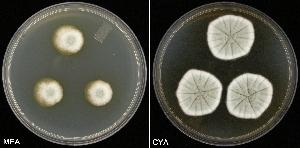
Penicillium canescens
Penicillium species are moulds found commonly associated with soil, decaying organic matter, and as storage rots or pathogens of fruits and vegetables. They are usually asexual members of the Eurotiales in the Ascomycota, although some species also produce a sexual state. Morphologically, the species are distinguished by their brush-like sporulating structures, which produce long green chains of dusty, single celled spores. They are equally well known for biodeterioration of organic matter, for their production of antibiotics such as penicillin and griseofulvin, toxic metabolites (mycotoxins) such as ochratoxin A, patulin, and penitrem A in food and grain, and their starring roles in camembert and blue cheeses. Some Penicillium species can also release fixed phosphorus (P) in the soil and make it available to growing plants. Compared with other nutrients, P is the least mobile and available to plants in most soils. P-solubilizing fungi play an important role in the global P cycle and can supply P to plants in an environmentally friendly and sustainable manner. Penicillium canescens grows in soil and can degrade plant matter through abundant xylanase and glucosidase production. P. canescens is a moderate calcium phosphate solubilizer, but has potential as an organic phosphate releaser through its plant degrading activities. The P. canescens genome will help to unravel mechanisms of P solubilization and fungal contributions to the P cycle.
